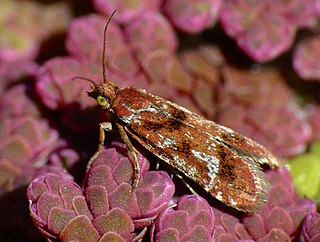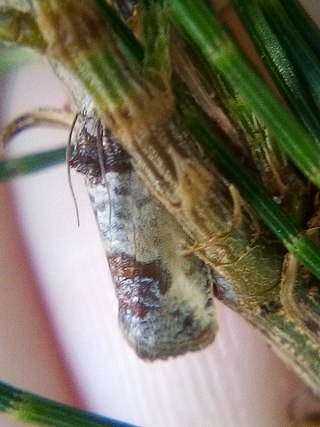
Hendecasticha is a genus of moths belonging to the subfamily Olethreutinae of the family Tortricidae. This genus was described by Edward Meyrick in 1881. It consists of only one species, Hendecasticha aethaliana, which is endemic to New Zealand.

Zealandopterix zonodoxa is a moth of the family Micropterigidae. It is endemic to New Zealand and is located from Hawkes Bay north as well as on Poor Knights, Little Barrier and the Great Barrier Islands. It is the smallest micropterigid in New Zealand and the shiny white markings on the forewing of this species display variation. It is a moth that is active during the day, but has been collected using UV light. Adults are on the wing from September to March and the species has been witnessed visiting the flowers of Nīkau and Cordyline pumilio in large numbers. It inhabits a wide variety of moist indigenous forest but is associated with forests in which podocarps are common. Larvae have been sieved from rotten wood on the floor of a mixed podocarp/broadleaf forest or extracted from moss or from bryophytes.

Cryptaspasma querula is a moth of the family Tortricidae. It is endemic to New Zealand and can be found throughout the country. This species inhabits podocarp and broadleaf forest. The larvae consume parts of the seeds and fruits of tawa, tarairi and miro trees and are predated upon by the invasive to New Zealand house mouse. Larvae pupate in leaf litter under their host trees. Adults are variable in appearance and also in size. They are on the wing throughout the year and are nocturnal but are attracted to light. They can be found having flown inside houses and have also been observed resting on fences or other human made structures during the day.

Planotortrix avicenniae is a species of moth of the family Tortricidae. It is endemic to New Zealand. It is found in the North Island and its larvae feed on mangrove trees.

Planotortrix flammea is a species of moth of the family Tortricidae. It is endemic to New Zealand.

Planotortrix notophaea, the blacklegged leafroller, is a species of moth in the family Tortricidae. It is endemic to New Zealand. It was also present near Sydney in Australia, but this population is thought to be extinct.

Epichorista aspistana is a species of moth of the family Tortricidae. It is endemic to New Zealand and has been collected in Canterbury and Otago. This species inhabits moist grassy areas at altitudes ranging from sea level to 1650m. Larvae feed on species within the genus Acaena. Adults are on the wing in November to February.

Protithona fugitivana is a species of moth of the family Tortricidae. It is endemic to New Zealand.

Tortrix demiana is a species of moth of the family Tortricidae. It is endemic to New Zealand. It is likely that this species probably belongs to another genus and as such this species is also known as Tortrix (s.l.) demiana.

Argyroploce chlorosaris is a species of moth in the family Tortricidae first described by Edward Meyrick in 1914. This species is endemic to New Zealand. The classification of this moth within the genus Argyroploce is regarded as unsatisfactory and in need of revision. As such this species is currently also known as Argyroploce (s.l.) chlorosaris.

Strepsicrates sideritis is a species of moth in the family Tortricidae first described by Edward Meyrick in 1905. This species is endemic to New Zealand. The classification of this moth within the genus Strepsicrates is regarded as unsatisfactory and in need of revision. As such this species is currently also known as Strepsicrates (s.l.) sideritis.

Bactra noteraula is a species of moth of the family Tortricidae first described by Thomas de Grey, 6th Baron Walsingham in 1907. It is endemic to New Zealand.

Cnephasia latomana is a species of moth in the family Tortricidae first described by Edward Meyrick in 1885. However the placement of this species within the genus Cnephasia is in doubt. As a result, this species may be referred to as Cnephasia (s.l.) latomana. This species is endemic to New Zealand.

Cnephasia microbathra, also known as the brownshouldered leaf-tyer, is a species of moth of the family Tortricidae. It was first described by Edward Meyrick in 1911. This species is endemic to New Zealand.

Cnephasia ochnosema is a species of moth in the family Tortricidae first described by Edward Meyrick in 1936. However the placement of this species within the genus Cnephasia is in doubt. As a result, this species may be referred to as Cnephasia (s.l.) ochnosema. This species is endemic to New Zealand.

Dipterina imbriferana is a species of moth in the family Tortricidae first described by Edward Meyrick in 1881. This species is endemic to New Zealand.

Holocola charopa is a species of moth in the family Tortricidae. It was first described by Edward Meyrick in 1888. It is endemic to New Zealand and has been observed in the northern parts of the North Island. The larvae web together and feed on the new shoots of their host plant Kunzea ericoides. Adults are on the wing in July and from November until February.

Holocola emplasta is a species of moth in the family Tortricidae. This species is endemic to New Zealand and has been observed in the South Island. The larval hosts are species within the genus Coprosma. Adults of the species are on the wing during the New Zealand spring months.

Prothelymna potamias is a species of moth in the family Tineidae first described by Edward Meyrick in 1909. This species is endemic to New Zealand.
Zomariana doxasticana is a species of moth of the family Tortricidae. It is found in Australia and sporadically in New Zealand. This species has not been recorded since 1999. It has been hypothesised that it is immigrant that sporadically establishes.




















